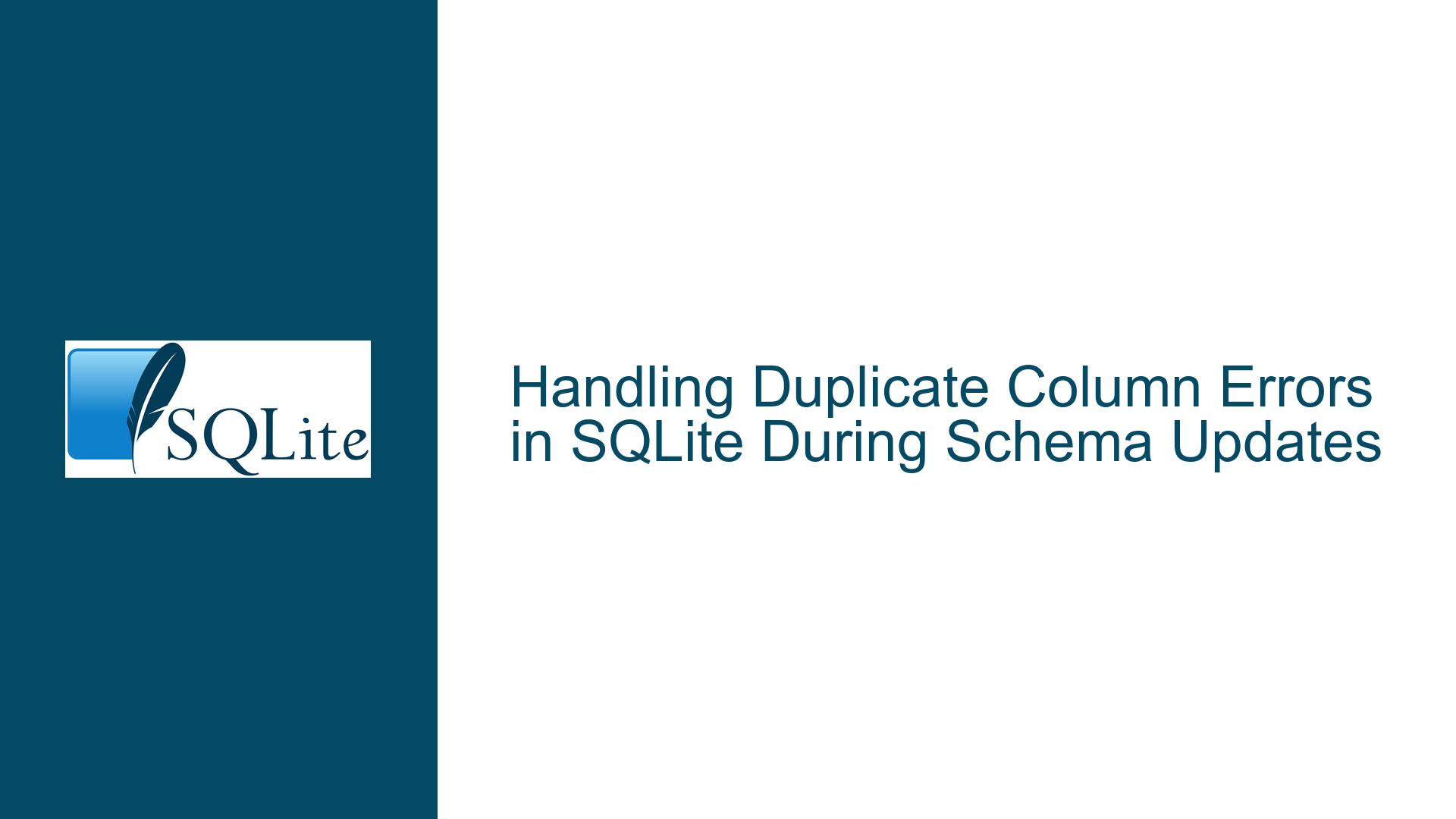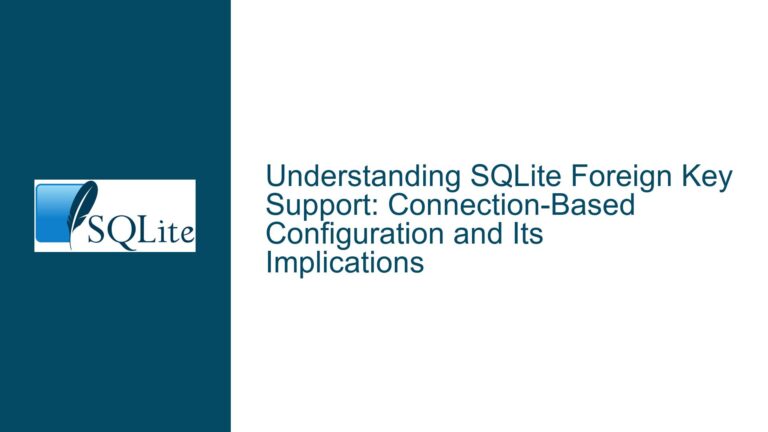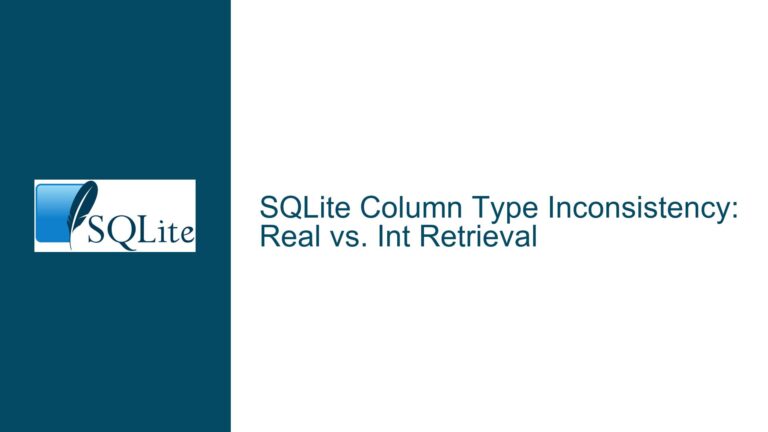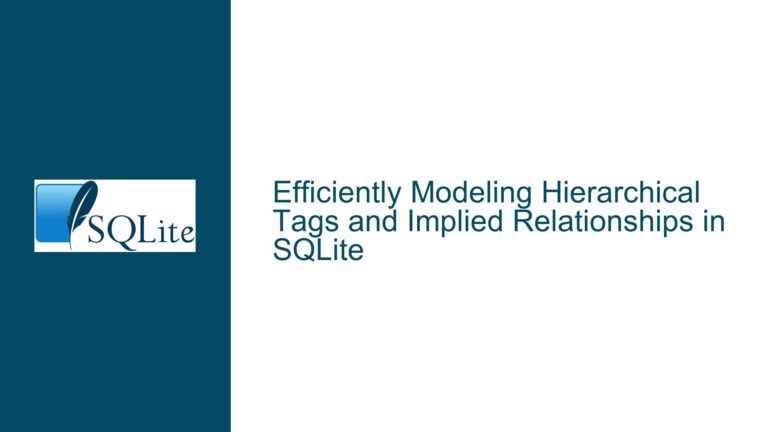Handling Duplicate Column Errors in SQLite During Schema Updates
ALTER TABLE ADD COLUMN Failures Due to Duplicate Column Names
When working with SQLite databases, schema evolution is a common requirement as applications grow and new features are added. One of the most frequent schema changes is adding new columns to existing tables. However, this process can become problematic when the same schema update is attempted multiple times, leading to duplicate column errors. This issue is particularly prevalent in distributed applications where different versions of the software might attempt to apply the same schema changes.
The core problem arises because SQLite does not support the IF NOT EXISTS clause for the ALTER TABLE ADD COLUMN statement. This means that if a column already exists in a table, attempting to add it again will result in an error. The error message, while descriptive, is not easily programmatically distinguishable from other types of errors, making it difficult to handle gracefully in application code.
The absence of a built-in mechanism to check for the existence of a column before attempting to add it forces developers to implement workarounds. These workarounds often involve querying the database’s metadata to determine whether a column exists, which can be cumbersome and error-prone. Additionally, the lack of a standardized approach can lead to inconsistencies in how schema updates are handled across different parts of an application or across different applications that use the same database.
Interrupted Schema Updates and Metadata Queries
One of the primary causes of duplicate column errors is interrupted or incomplete schema updates. In a distributed environment, where multiple instances of an application might be running simultaneously, it’s possible for one instance to successfully add a column while another instance, unaware of the change, attempts to add the same column again. This can happen if the schema update process is not properly synchronized across instances.
Another cause is the lack of a robust mechanism to check for the existence of a column before attempting to add it. While SQLite provides several ways to query the database’s metadata, such as the sqlite_master table and the PRAGMA table_info statement, these methods are not always straightforward to use. For example, querying the sqlite_master table requires parsing the table’s schema definition, which can be complex and error-prone. Similarly, using PRAGMA table_info requires executing a separate query for each table, which can be inefficient.
The reliance on metadata queries also introduces the risk of race conditions. If two instances of an application attempt to check for the existence of a column at the same time, both might determine that the column does not exist and proceed to add it, resulting in a duplicate column error. This is particularly problematic in high-concurrency environments where schema updates are frequent.
Implementing Robust Column Existence Checks and Schema Update Strategies
To address the issue of duplicate column errors, it is essential to implement robust mechanisms for checking the existence of columns before attempting to add them. One approach is to use the PRAGMA table_info statement to query the metadata of a table and determine whether a specific column exists. This method is relatively straightforward and can be implemented in a way that minimizes the risk of race conditions.
For example, consider the following SQL query, which checks for the existence of a column named newcol in a table named mytable:
SELECT COUNT(*) FROM pragma_table_info('mytable') WHERE name = 'newcol';
If the query returns a count greater than zero, the column exists, and the application can skip the ALTER TABLE ADD COLUMN statement. If the count is zero, the column does not exist, and the application can proceed with adding it.
Another approach is to use the sqlite_master table to query the schema definition of a table and parse it to determine whether a specific column exists. This method is more complex but can be useful in situations where the PRAGMA table_info statement is not available or not suitable.
For example, consider the following SQL query, which retrieves the schema definition of a table named mytable:
SELECT sql FROM sqlite_master WHERE type = 'table' AND name = 'mytable';
The result of this query is a string that contains the SQL statement used to create the table. This string can be parsed to determine whether a specific column exists. However, this method is more error-prone and should be used with caution.
In addition to implementing robust column existence checks, it is also important to ensure that schema updates are properly synchronized across different instances of an application. One way to achieve this is by using a distributed locking mechanism to ensure that only one instance of the application can perform schema updates at a time. This can be implemented using a separate table in the database that acts as a lock, or by using an external locking mechanism such as a file lock or a distributed lock service.
Another strategy is to use a versioning system to track schema changes and ensure that each instance of the application applies the correct set of updates. This can be implemented by storing a version number in a separate table in the database and incrementing it each time a schema update is applied. Each instance of the application can then check the version number before applying schema updates and only apply updates that are necessary to bring the database up to the current version.
Finally, it is important to handle errors gracefully and provide meaningful feedback to users when schema updates fail. This can be achieved by catching exceptions and logging detailed error messages, as well as providing users with instructions on how to resolve the issue. In some cases, it may be necessary to provide a manual update script that users can run to apply schema updates that could not be applied automatically.
By implementing these strategies, developers can minimize the risk of duplicate column errors and ensure that schema updates are applied smoothly and consistently across different instances of an application. This will help to maintain the integrity of the database and ensure that the application continues to function correctly as it evolves over time.
Conclusion
Handling duplicate column errors in SQLite requires a combination of robust column existence checks, proper synchronization of schema updates, and graceful error handling. By using the PRAGMA table_info statement or the sqlite_master table to check for the existence of columns, developers can avoid attempting to add columns that already exist. Additionally, by using a distributed locking mechanism or a versioning system, developers can ensure that schema updates are applied consistently across different instances of an application. Finally, by handling errors gracefully and providing meaningful feedback to users, developers can ensure that any issues that do arise are resolved quickly and efficiently.
Implementing these strategies will help to ensure that schema updates are applied smoothly and consistently, minimizing the risk of duplicate column errors and maintaining the integrity of the database. This will allow the application to continue to evolve and grow over time, without being hindered by schema-related issues.






